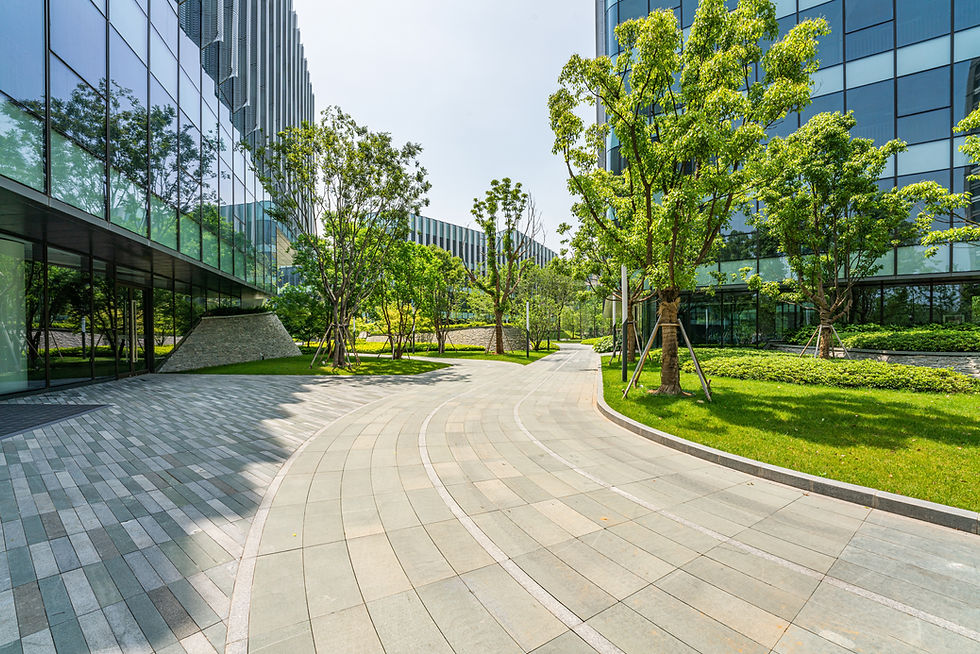The Role of Trees in Urban Commercial Landscaping in Oxford
- Brewood Landscapes

- Feb 29, 2024
- 3 min read

In the heart of Oxford, where historic spires meet the hustle and bustle of modern business, the inclusion of trees in urban commercial landscaping emerges as a silent yet profound force shaping the city's aesthetic and environmental landscape. Beyond their natural beauty, trees play a crucial role in enhancing the urban environment, offering a multitude of benefits that extend well beyond mere decoration. This blog delves into the significance of trees within Oxford's commercial landscapes, highlighting their impact on sustainability, well-being, and business appeal.
A Breath of Fresh Air
Oxford, renowned for its architectural beauty and academic heritage, is also a bustling urban centre with its fair share of pollution. Trees act as natural air purifiers, absorbing pollutants and emitting oxygen, thus significantly improving air quality. In commercial areas, where the concentration of vehicles and human activity exacerbates air pollution, trees become indispensable allies in creating healthier environments for businesses, employees, and customers alike.
Mitigating Urban Heat
The urban heat island effect, where city areas experience higher temperatures than their rural counterparts, is a growing concern in cities like Oxford. Trees provide a natural cooling solution, offering shade and releasing water vapour through transpiration. Strategically placed trees in commercial landscapes not only reduce the ambient temperature but also lower cooling costs, making them a cost-effective solution for businesses looking to enhance their sustainability credentials.
Enhancing Aesthetic Appeal and Business Value
The visual appeal of a well-landscaped commercial property cannot be overstated. Trees add a touch of elegance and tranquillity, making commercial spaces more inviting to potential customers and tenants. Furthermore, properties with mature, well-maintained trees often see an increase in their market value, demonstrating that investing in green infrastructure is not only beneficial for the environment but also for business profitability.
Promoting Biodiversity and Ecosystem Services
Urban landscapes can be challenging environments for wildlife. However, incorporating a variety of tree species in commercial areas provides essential habitats for birds, insects, and other urban wildlife, promoting biodiversity. Trees also contribute to ecosystem services such as stormwater management, reducing runoff and the risk of flooding — a particularly important consideration in Oxford's variable climate.
Supporting Well-being and Productivity
The presence of greenery, especially trees, in commercial settings has been linked to improved mental health and well-being. For businesses in Oxford, creating green spaces with trees can enhance employee satisfaction and productivity. Natural views have been shown to reduce stress and increase creativity, making trees a wise investment for any business looking to foster a positive workplace environment.
Navigating Challenges and Solutions
Incorporating trees into urban commercial landscapes is not without its challenges. Space constraints, underground utilities, and maintenance considerations can all pose barriers. However, with careful planning and the selection of suitable tree species, these challenges can be overcome. Urban tree species that are resilient, require low maintenance, and are suitable for Oxford's climate and soil conditions are ideal choices.
The role of trees in urban commercial landscaping in Oxford transcends mere aesthetics. They are pivotal in crafting sustainable, healthy, and appealing commercial environments. By prioritising tree planting and maintenance in urban planning, Oxford can continue to thrive as a city that respects its environmental responsibilities while enhancing the well-being of its inhabitants and the success of its businesses. For commercial property owners and businesses, investing in trees is not just a nod to environmental stewardship but a strategic decision that pays dividends in health, aesthetics, and economic value.




Comments